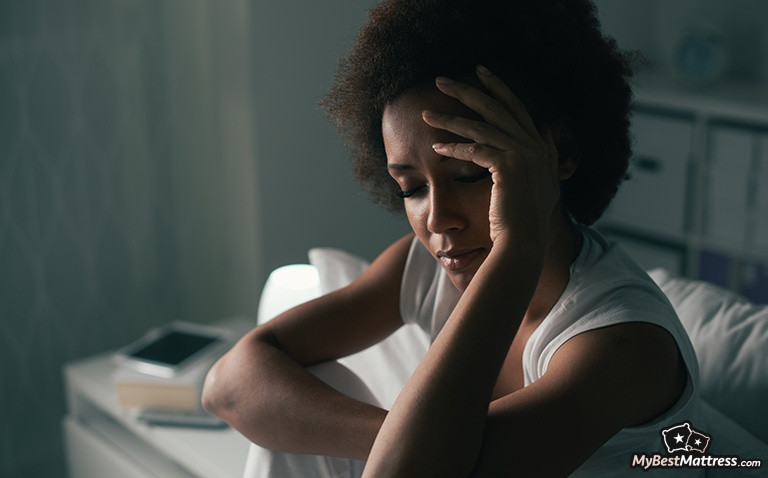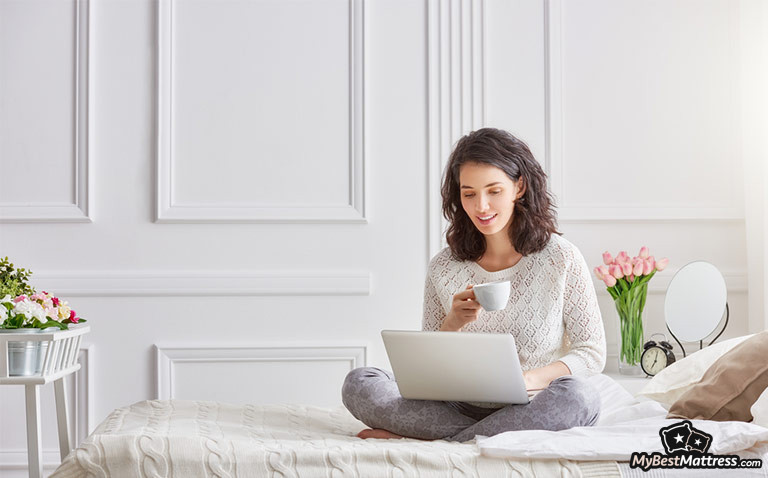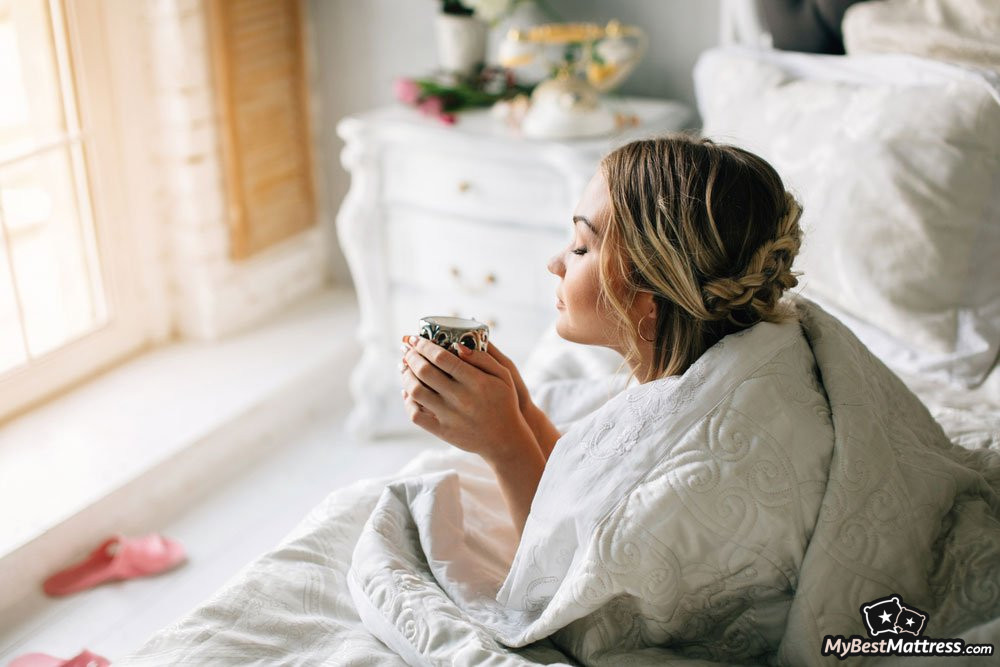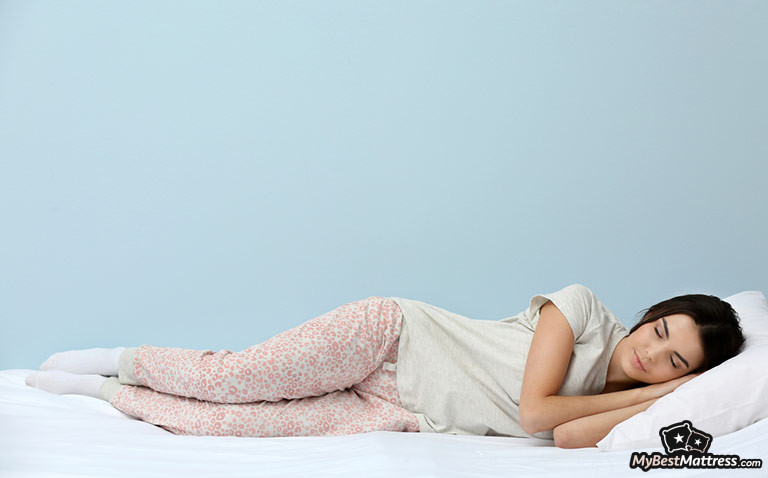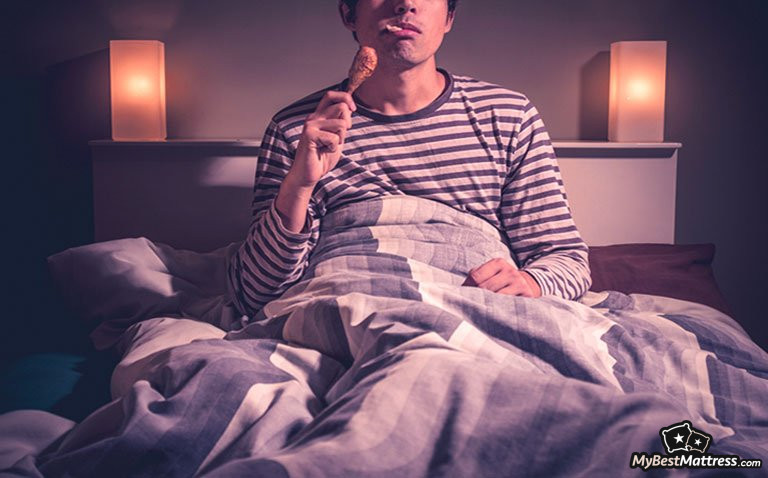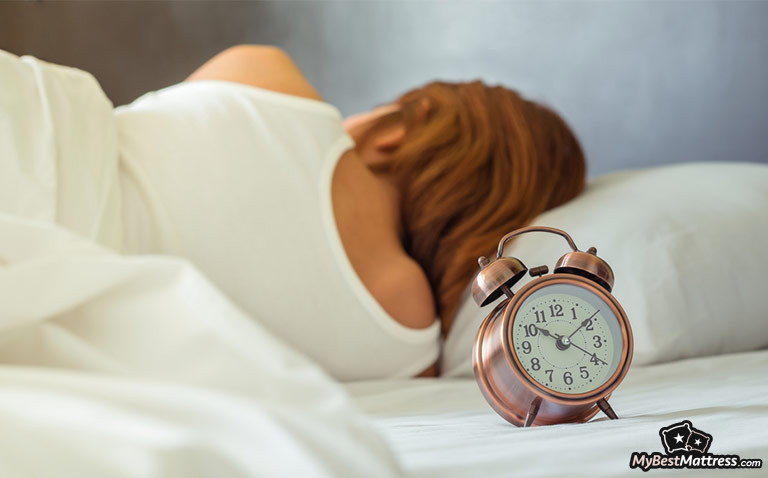MyBestMattress is an independent, personal project. All the content on this website is free to use.
You can help keep the site free & unbiased by donating. Your support is highly appreciated!
Are you looking for ways to improve your sleep quality? Do you endlessly toss and turn at night, watching the minutes tick away? Is one of your goals to learn how to fall asleep faster?
While problems falling asleep that plague your nights and days might make you feel desperate, there’s no need to lose hope. There are many ways you can not only improve your sleep, but even prolong it. All you have to do is figure out how to fall asleep when anxious or otherwise distressed.
It might sound far easier said than done. However, there are plenty of ways to even help you learn how to fall asleep in 2 minutes! And there’s a common thread between a lot of the advice – they have something to do with your main senses.
So, let’s take a closer look at how sound can make it harder for us to fall asleep – and what sounds to fill your ears with if you’re looking for ways how to fall asleep faster.
What Makes it Hard to Fall Asleep Faster?
Our everyday lives are hectic, and sometimes it seems like we barely have a minute to pause and breathe. It’s no wonder that the stress of the day affects the quality of our sleep, too – according to statistics, disorders like insomnia or sleep anxiety affect more than half of the U.S. population.
While there are tools like sleep calculators that help you determine when you should go to bed to get sufficient sleep, that can be hard to achieve if it takes you ages to fall asleep, in the first place. It’s a lot harder to focus on how to fall asleep when anxious or mentally overstimulated.
If your mind keeps running through the events of the day, or thinking about everything you need to do tomorrow, sleep might be the last thing you can focus on. Constant swirls of thoughts can lead to the brain associating sleep time with stress, which makes it even harder to fall asleep fast.
There can be numerous reasons why our brains take such a long time to quiet down and rest for a few hours. Anything from internal worries about life to external stimuli like blue light or unpleasant temperature can prolong the time it takes for us to fall asleep, leading to less than stellar rest quality.
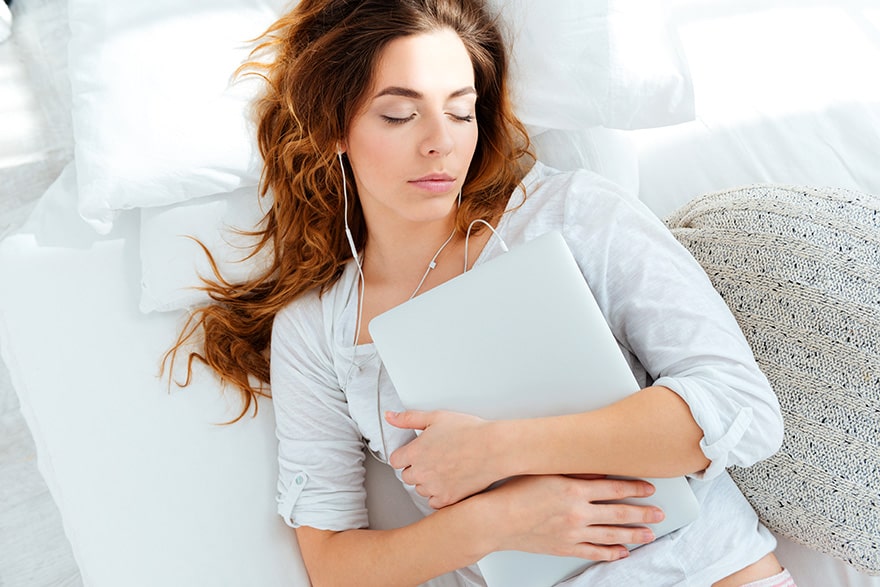
A group of researchers determined a framework of the key causes for insomnia and sleep disturbances, known as the 3P model:
- Predisposing factors: influenced by genetics, social, or psychological factors;
- Precipitating factors: caused by specific events, such as having a baby, losing a job, or grieving;
- Perpetuating factors: maladaptive behavior and negative thinking styles can continuously negatively impact sleep onset, or the time it takes to fall asleep.
External triggers can also play a big role in sleep onset. You may have heard that light makes it hard to fall asleep since it stimulates the brain. Various light sources can be irritating even when you keep your eyes closed. They can also affect the production of melatonin.
Sound can have a very similar effect on your quality of sleep. If you live in big cities or near active roads, you might be used to hearing all sorts of noise throughout the night – from trucks to loud passers-by just outside your windows. In fact, research shows that environmental noise can be detrimental to your sleep quality.
Sounds can truly make or break the sleep experience. While having to cover your ears with a pillow and losing precious time you could have spent asleep might only seem mildly annoying short-term, if these interruptions in your sleep routine are prolonged, you could end up dealing with serious health issues, like high blood pressure or heart problems.
How to Leverage Sounds to Help You Sleep?
So, we’ve covered how sounds can disrupt your attempts to rest. But not all tones are bad for your sleepy brain. In fact, there is a whole wide range of sounds to help you sleep. Scientists have proven that certain choices of music and specific frequencies can not only help you enjoy deeper rest, but also finally crack the puzzle of how to fall asleep faster.
There are some things to keep in mind before you start adding auditory experiences to your How to Sleep Faster plans.
Firstly, be careful with headphones or earphones. While they may be the most convenient way to immerse yourself in sound, prolonged listening at a too-high volume can cause permanent hearing damage and conditions like tinnitus.
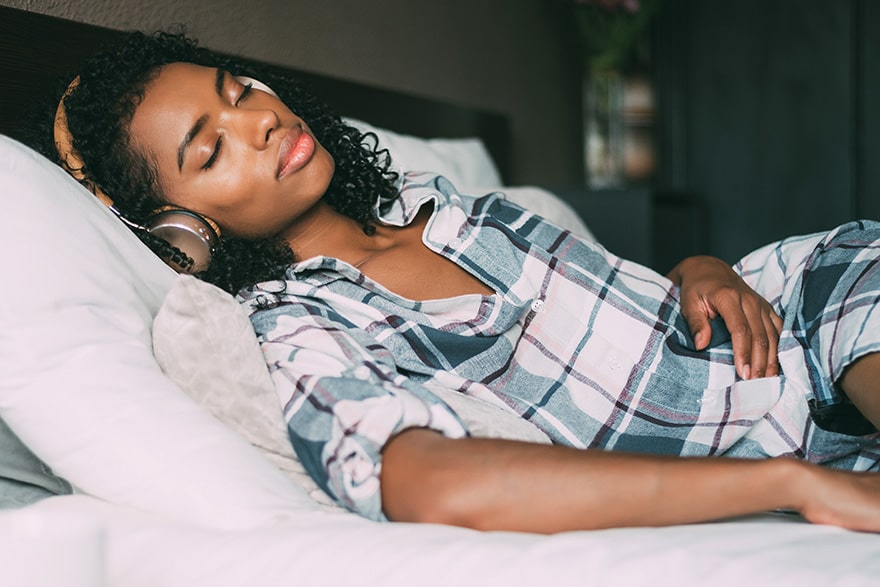
Secondly, be mindful of what sounds you choose. If the soundtrack elicits very intense emotions, your brain can start associating them directly with bedtime. Instead, try going for something neutral to ensure calmness and relaxation.
Thirdly, just because something works for another person, doesn’t mean it’ll work for you. Our brains are all wired differently. Play around with different frequencies and sound combinations to see what yields successful results and aids in how to fall asleep when anxious.
Unsure what works best for you? You don’t have to dig through your memory trying to recall every noise that made you jump in the middle of the night. Our Sleep Sounds tool offers a selection of more than 30 sounds to aid your rest. From natural soundscapes and warm indoor chatter to a range of noise frequencies, every ear will find something comforting.
If you want to put this theory into practice, you can find our collection of the best sleep sounds above and make a playlist of your favorites. Or, if you want to try the recommended calming sounds, select one of our presets and simply adjust the volume levels to your preference.
But first, let’s find out what the Noises we’re offering are and why we’ve chosen them as the best sleep sounds. Here are some of our tips and tricks on how sounds can help you sleep.
Tip 1: Ambient environments
Imagine yourself sitting in the middle of a forest, listening to the crackling of logs in the bonfire. Or the chirping of crickets by the river on a hot summer day. How about the rhythmic tapping of raindrops against the rooftop?
All these scenarios may elicit a psychological reaction from you and possibly even make you feel calmer. The sounds that have been described here are ambience – atmospheric environments that have been proven highly effective as sounds to help you sleep.
In fact, if you were to look up “sounds to sleep by” online, the top results you’d find would be compilations of ambient soundscapes and atmospheric playlists.
There are several types of ambience that you’ll find among our list of calming sounds – natural, artificial, and social. The latter two can describe a wide range of sounds that you won’t find in natural environments – from the whirring of a fan to the warm bustle and chatter inside a coffee shop.
Nature sounds are generally the preferred bedtime environment. Ocean waves, bonfires, and rainstorm sounds are among the most popular choices for ambience. These calming sounds have been proven not only to be a helpful solution for how to fall asleep faster, but also aided in reducing awakenings throughout the night.
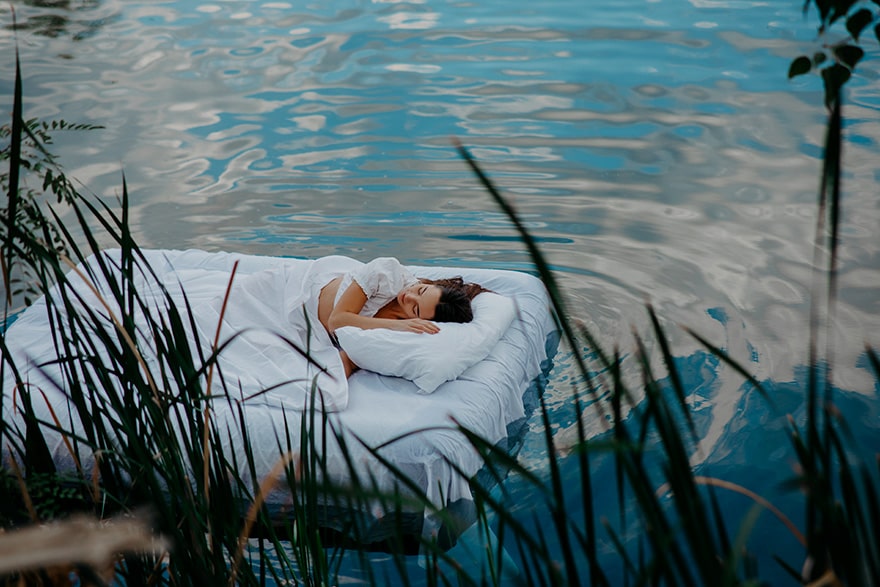
When it comes to artificial ambience, these tend to refer to mechanical sounds. While drilling or hammering are unlikely to be perceived as calming sounds, transport vehicles provide great ambience for sleep. Just think about how easy it sometimes is to fall asleep on a plane or a motorboat.
The sound of an engine whirring has proven to be a particularly effective lullaby for young children. In fact, Ford developed a special smart crib that connects to the car via bluetooth and simulates the engine sound to help babies sleep faster. So, if you’re wondering how to fall asleep faster and sleep like a baby, the answer is nightly car rides!
While not much research has been done about social ambient environments, like coffee shops or muffled party sounds, they also appear to be among popular choices for concentration and sleep backgrounds. Hearing the background chatter may help those who struggle with how to fall asleep when anxious or lonely.
Some ambient sounds can be used as a “soundtrack” for meditation or a way to let your imagination run loose. Your brain can use sounds to sleep by the fire or near the ocean by imagining these environments. Getting into the habit of meditating before sleep while listening to ambience can be a good way to practice how to fall asleep faster.
So, how do you know which ambient sounds work better for you? Would you rest better in the middle of an imaginary forest, or would the faded chatter of a cocktail party lull you to sleep in a matter of minutes? You can put it to a test – select one of the presets on our Sleep Sounds playlist, or create your own selection of sounds to sleep by!
More than half the options on the Sleep Sounds tool are ambient soundscapes of every branch that we’ve just covered. You can mix and match them to create your own imaginary comfort space.
Why not imagine yourself looking out the window in a rainy city not far from a waterfall, or sitting by a bonfire on a summer night? Perhaps you can even end up dreaming of these sceneries!
Tip 2: White Noise
The word “noise” may sound counterproductive – after all, environmental noise is known for disrupting the quality of sleep rather than improving it. However, in terms of calming sounds, noise refers to audio frequencies that the human ear reacts to as different tones.
There can be some overlap between ambient calming sounds and color noises. Some frequencies can be described as rainstorm sounds, roaring, buzzing, or other terms used for ambience. Noises simply focus on the environmental sounds on a micro level, while ambience is about building the whole atmospheric environment.
Tonal noise is categorized into different groups based on their frequency, using color names to determine the spectrum. While there are six different colors of noise, we’ll be taking a look at the effectiveness of three groups, starting with white noise.
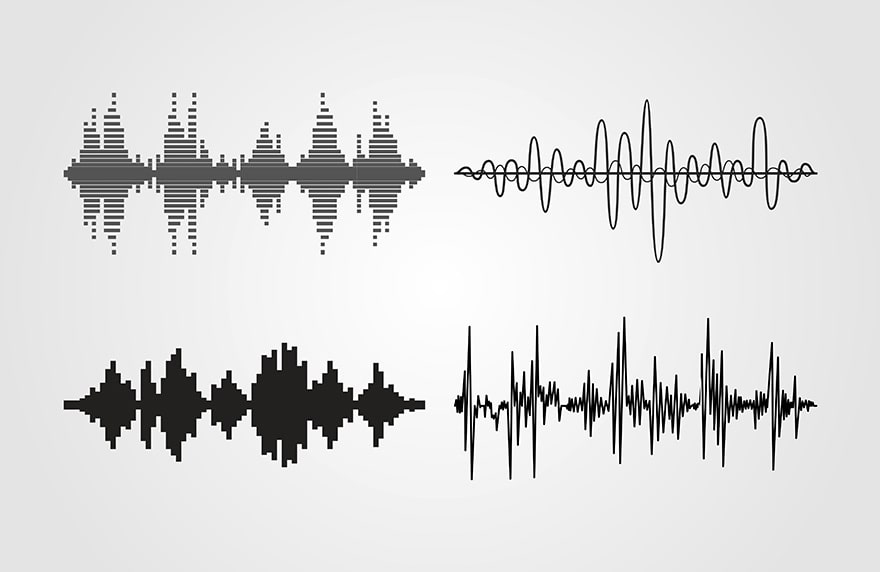
White noise is a combination of all frequencies that creates a specific hissing sound. Think of something like the TV static – it’s the auditory experience of watching the screen flicker. In contrast, black noise is the complete absence of sound.
Whirring, buzzing, and humming are some of the words used to describe the experience of white noise. Studies have shown that using white noise to drown out other background sounds helps hospital patients improve their sleep onset. One research stated that patients who slept next to white noise machines fell asleep 38% faster.
Many sleepers use white noise machines to drown out annoying or intrusive sounds. White noise machines produce specific frequencies that can calm the brain and help the body relax. Some white noise machines can even produce a wider spectrum of calming sounds, such as rustling leaves.
You can find more information about white noise machines and what the best options in the market are by clicking here. But if you’re looking for a free option, you’re in the right place – our Sleep Sounds tool offers white noise as one of the possible options. Listen to it on its own, or combine it with other ambient sounds, and see its effects for yourself!
White noise is commonly used as an umbrella term to describe not only this particular blanket of sound, but also pink and brown frequencies. White noise mobile apps—much like our Sleep Sounds tool—offer a wide range of sounds, from pure white noise, to calming sounds you’d hear in nature.
Tip 3: Pink Noise
Pink noise describes sounds at a mid-to-low frequency. The higher frequencies are dimmed out while the lower ones are more prominent. Pink noise is associated with steady, rhythmic sounds like the heartbeat, rustling leaves, and the crashing of waves. No wonder that pink noise has proven to be effective – we hear it before we’re even born!
In fact, pink noise has been one of the most effective auditory tools to improve the overall sleep quality. Not only is pink noise effective as a tool for those looking into how to fall asleep faster, it also helps maintain a deeper, more restful sleep throughout the night.
Since the pattern of pink noise can be described as pulsing, it may help regulate your heart rhythm and put your body into a state of relaxation. Pink noise could be used along with meditation or breathing exercises to help those struggling with how to fall asleep when anxious.
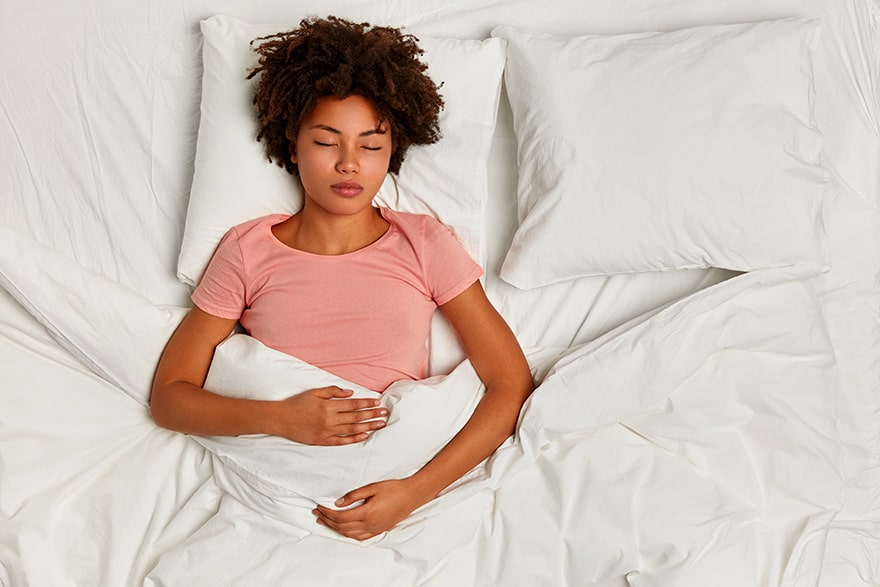
There might be some psychology to the effectiveness of pink noise, as well – the sounds are rhythmic and repetitive, creating a type of “routine” for the ear. Building a consistent routine around your bedtime is a great way to improve your ability of how to fall asleep faster. So, creating an association between pink noise and bedtime might be helpful.
Keep in mind that there hasn’t been as much research done into the benefits of pink noise. However, so far evidence suggests that pink noise can be beneficial for those struggling with their sleep onset and relaxing before bedtime.
Pink Noise vs White Noise
When it comes to comparing pink noise vs white noise, the key difference is the frequencies they both emit. White noise is the overlay of all frequencies that acts as a blanket of sound, whereas pink noise consists of certain lower frequencies.
Pink noise can be described as pulsing and rhythmic. Research has shown that pink noise improves the stability of sleep and reduces brain activity. White noise, which is a wave of static frequencies, has been shown to help fall asleep faster and experience fewer disruptions.
Some people may consider pink noise to be more pleasant to the ear as it contains fewer frequencies which are mostly at a lower range. Pink noise is less intense, reminiscent of a thumping heart.
For those who struggle with how to fall asleep faster due to tinnitus, white noise may be the preferred option. According to one study with people suffering from tinnitus, two thirds of the queried found white noise to be the most soothing, while none of the participants chose pink noise.
Whether pink or white noise is better for you will depend on how your brain responds to either set of frequencies. If you want to find out, select “Pink Noise” or “White Noise” in our Sleep Sounds tool above.

Did you know?
Have you ever wondered which mattresses are approved as the best for sleep?
See & compare TOP mattresses side by sideTip 4: Brown Noise
Brown noise, also known as red or Brownian noise, can be heard at lowest frequencies of the three mentioned here. If you want to imagine what brown noise sounds like, think of the roar of a waterfall or heavy summer rain.
Brown noise is very effective for concentration. The lower frequencies of heavy rainstorm sounds help drown out other background noise and pull your focus away from distractions. It’s considered to be bass-heavy, so your heartbeat might adjust to the low rhythmic rumble and help you calm down.
Research into the advantages of brown noise in helping with how to fall asleep faster is limited. However, it seems to suggest that brown noise can be used to help improve sleep onset and quality.
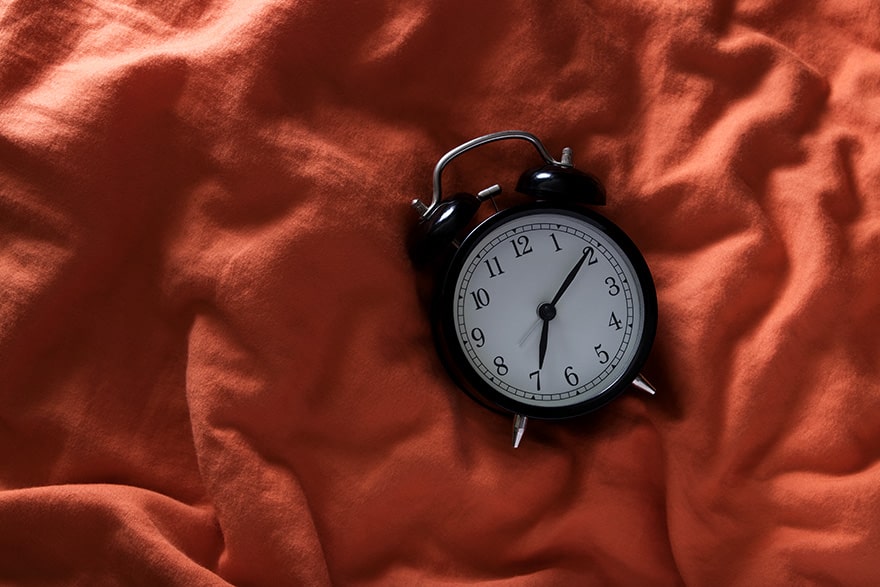
Furthermore, natural sounds that are associated with the low frequencies of brown noise, like thunder or heavy rainstorm sounds, have been shown to aid struggling sleepers. So, brown noise may be a safe bet for sleep onset management.
If you want to see how effective brown noises are as sounds to sleep by, you can find a few options among the selection of sounds offered by our Sleep Sounds tool – try the pure “Brown Noise” option or the more ambient “Close Waterfall”. You can also compare these frequencies with pink and white noise, and see what aids your sleep best.
Brown Noise vs White Noise
White noise and brown noise can sound similar to the human ear. Brown noise covers a predominantly low register of frequencies while white noise encompasses the whole range, producing a similar humming sound. Both sets of frequencies are good at drowning out background noise and sudden sounds.
Brown noise may be a better option for those who find white noise too loud or high-pitched as it does not transmit the same high frequencies. Think of white noise as watching a waterfall from afar while brown noise is like sitting right under the stream.
There has not been as much research done into how sleep can be positively influenced by brown noise vs white noise. It might be more difficult to determine which of the two is better for those who want to know how to fall asleep faster.
However, you can do a little experiment of your own! On our Sleep Sounds tool, you’ll find options for both white and brown noise. Give them a listen and see what aids you in your journey of learning how to fall asleep faster.
Tip 5: ASMR
Autonomous sensory meridian response, or ASMR, has become widely known in recent years thanks to the internet. Many people describe ASMR as a static or tingling sensation that starts at the neck and flows through the body.
Although some might mistakenly think that the ASMR is the specific sound being created, the acronym actually refers to the physical response to the sound. ASMR has developed a community online, with millions of recordings and videos available on platforms like YouTube or Spotify.
Although visuals can also have this effect on the body, sound is the stimulus that most people speak of. One of the most common triggers for ASMR is whispering. However, there is a wide range of calming sounds that can elicit a physical reaction, such as:
- Turning the pages of a book
- Gently tapping wood or metal
- Crinkling paper
- Tapping on a keyboard
While some of the triggers for ASMR, such as clicking mouth noises, may not seem like the best sleep sounds, they may still get the brain to react in a way that eases it into sleep. Some studies have shown that the tingling feeling of ASMR can relax the body into a sleep-inductive state.
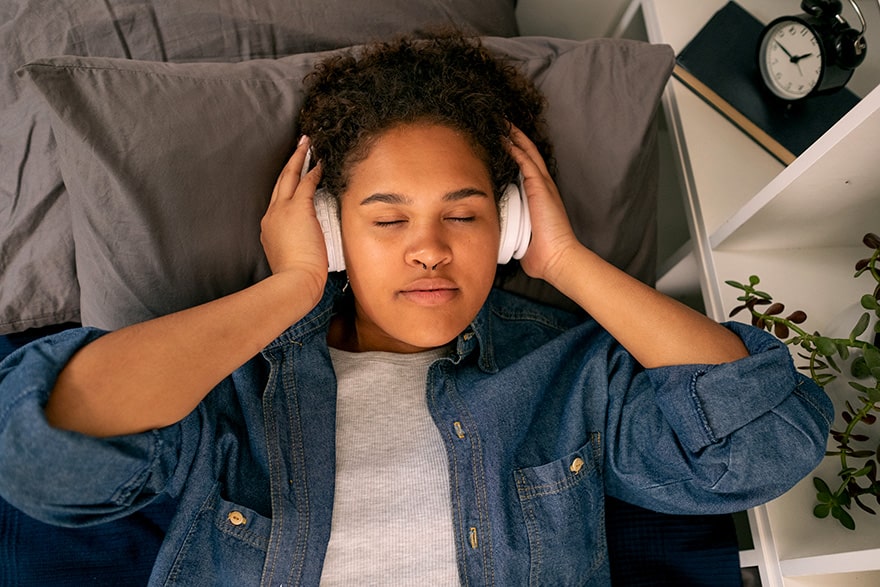
However, ASMR may not be a helpful solution to everyone. While some people find the feeling pleasant and relaxing, others have reported that ASMR made them feel more intense and had a very opposite effect than expected. For some, the reaction is more similar to hearing nails on a chalkboard.
In some cases, people may not have any physical response to the sounds whatsoever. However, don’t knock it till you’ve tried it. Play around with the sounds on our Sleep Sounds playlist and see if anything in our collection of the best sleep sounds gets your skin tingling.
We even have a few recommendations for the best sleep sounds to trigger ASMR. Try out “Bonfire”, “Rain Drops”, or “Wind Chimes”. Does any one sound make your body respond pleasantly? Perhaps a combination of a few might – feel free to make playlists of your own!
Tip 6: Music
Music may be the most obvious choice for calming sounds to turn to when they’re struggling to fall asleep. After all, among the wide array of genres, there are some dedicated specifically to aid how to fall asleep faster.
From the classics of Chopin and Debussy to contemporary Lo-Fi mixes, there are countless compositions and songs that can help ease your brain into a state of relaxation. In fact, there’s a whole scientific branch dedicated to analyzing how the brain reacts to music, called music psychology.
As a scientific branch, music psychology has dedicated a decent amount of focus to how melodies can aid or harm us in our sleep. Unsurprisingly, a lot of the research looks into classical music and how well our brains respond to instrumental compositions.
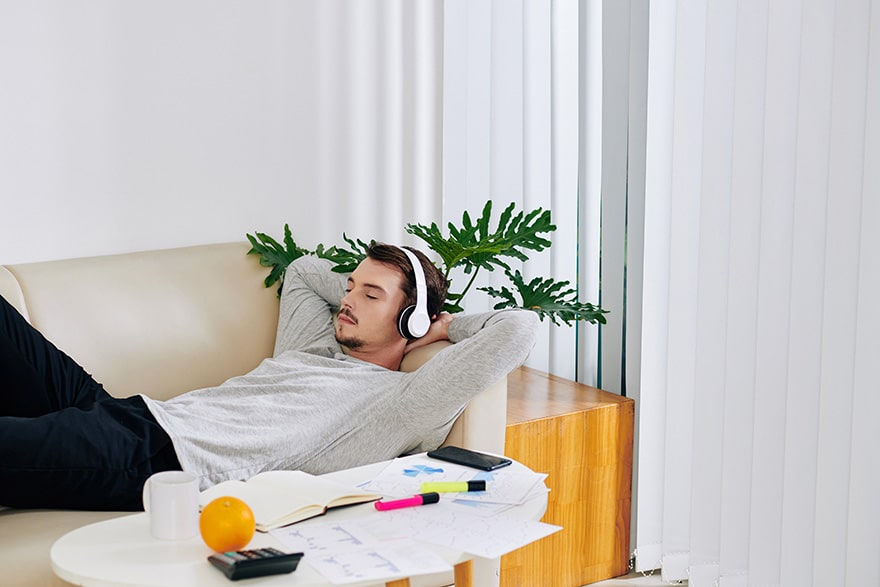
A study conducted by researchers at the University of New South Wales showed that music with low rhythmic activity can be as successful in aiding sleep as some medications. 78% of the research participants found that music positively impacted their sleep onset.
Music has been proven to aid people of all age groups, from newborns and toddlers to adults. According to a study on sleep in older women, introducing music in their bedtime routine helped them cut down their sleep onset time roughly four times. So, setting up a nightly playlist will certainly help with how to fall asleep faster.
Not all music relaxes the brain, though. While some people swear that their secret of how to fall asleep in 2 minutes is to put a metal playlist on, this is far from a universal experience. So, mess around with the playlist of your favorite tracks and see if any of them make your eyelids feel heavy.
Alternative Methods
Unfortunately, not everyone can find it easy to sleep if they hear any type of sound. Some people suffer from a condition known as misophonia. The term means “hatred of sound” in Greek. People who experience misophonia can have adverse reactions to sudden sounds, feel irritated, upset, or even angry at certain auditory stimuli.
If you find that calming sounds don’t help you improve your sleep quality, don’t worry – there are more changes you can make to figure out how to fall asleep faster, from managing your breathing patterns to improving your surroundings.
And even if you find auditory relaxation helpful, why not try a couple of methods in tandem? Who knows, maybe you’ll discover the secret to how to fall asleep in 2 minutes!
The 4-7-8 Method
One of the most effective ways for those looking into how to fall asleep faster is the 4-7-8 method. It’s a breathing technique that helps the body and the mind relax. It’s been said that using the 4-7-8 breathing model is perfect for those who want to learn how to fall asleep in 2 minutes!
The principle of 4-7-8 is easy – all you have to do is follow these steps:
- 1. Slightly open your mouth and make sure your tongue rests behind your front teeth;
- 2. Breathe in through your nose for 4 seconds;
- 3. Hold your breath for 7 seconds;
- 4. Exhale for 8 seconds. You should hear a slight whooshing sound as you exhale;
- 5. Repeat the cycle several times.
The 4-7-8 breathing technique can be done in combination with meditation. Since the body relaxes and the heart rate stabilizes according to the breathing pattern, this method has been proven effective among those who struggle with how to fall asleep when anxious.
Some practitioners of the 4-7-8 method said that it takes them 3-4 cycles to drift off. So, instead of counting sheep, why not try counting your breaths?
The Military Method
While the name might sound intimidating, the military method is actually an efficient way to relax your body before sleep. Some even say that it’s the answer to how to fall asleep in 2 minutes!
The goal of the military method is to relax every part of your body, moving top to bottom. It might take a little while to become a pro. However, the steps you need to take are pretty simple:
- 1. Lie down on your bed and make sure that you’re comfortable;
- 2. Drop your shoulders to release the tension in your body and keep your arms by your sides;
- 3. Take deep breaths to relax your chest;
- 4. Work your way through relaxing your legs, feet, and toes;
- 5. Relax your mind and imagine calming scenarios for about 10 seconds;
- 6. If your imagination isn’t working, repeat the words “don’t think” in your mind for 10 seconds;
- 7. Try to move past any intrusive thoughts and focus only on clearing your mind.
Following the military method should help you handle the problems of how to fall asleep faster. You should have no issue falling asleep after the final 10 seconds. Repetition is key, so if you practice this every night, you should be able to improve your sleep onset.
Adjusting the Sleep Environment
Where you sleep is as important as how you sleep. No amount of calming sounds or breathing exercises will be good enough if your bed feels more like a rock slab. You might need to take a step further and work on making your sleep environment comfortable and relaxing.
Let’s start with your bed – how long has it been since you last changed your mattress? An old mattress can not only cause you physical discomfort, but also impact your health. After years, the buildup of dust and bacteria could cause allergies, while the lack of support might make your neck and back ache.
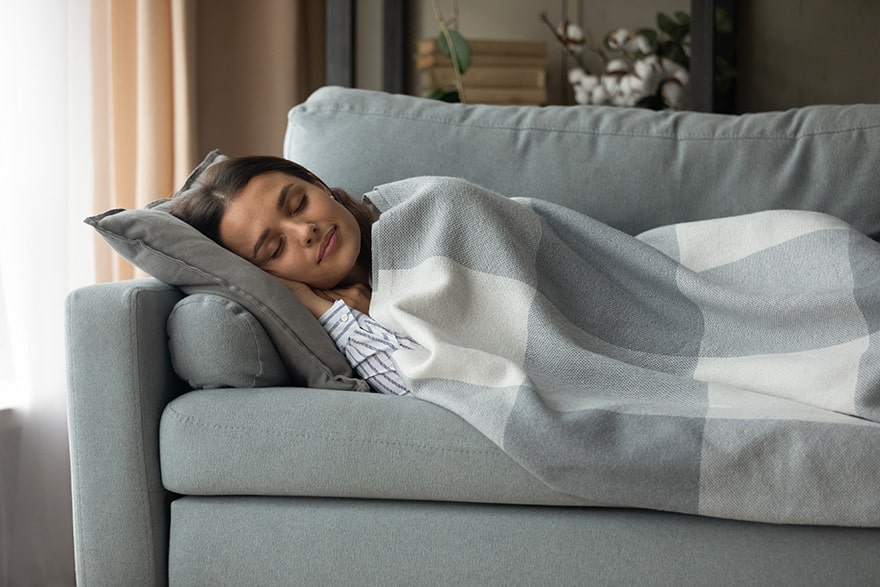
So, it might be time to get a brand new mattress that will support your body and help you feel so comfortable you don’t even need to worry about how to fall asleep faster anymore.
And don’t worry, we’ve made it easy for you – we have prepared a handy-dandy list of the best mattresses on the market so you can save time on your search and spend it sleeping comfortably, instead.
UP TO $500 OFF
Limited-time Saatva Sale
We're sharing a limited-time Saatva mattress discount with our readers! Grab this deal & enjoy your new mattress with huge discounts.
Next up? Bedding. It’s just as important as what your back rests on. Like mattresses, pillows and duvet covers can deteriorate over time. Take a look at our options for the best pillows and duvet covers, and transform your bed into the temple of the coziest, fastest sleep.
Conclusions
So, have you found your answer to the question of how to fall asleep faster? Introducing calming sounds to your bedtime routine can certainly help – it can drown out unnecessary or sudden noise, relax your heart rhythm, and put your body in a calm, restful state.
You can also introduce sounds into your other sleep routines, like meditation, to yield the best results and even learn how to fall asleep in 2 minutes. Auditory aid can transform bedtime from anxiety-inducing to something you look forward to each night.
And you don’t need to look far to start your soundful sleep journey – just scroll up and try out our Sleep Sounds tool! Use one of our presets or build your own personalized playlist, and see for yourself how to fall asleep faster with ease.
Now that you know how to improve your sleep onset, you might want to adjust your overall bedtime pattern to make sure you’re always well-rested and full of energy. Check out our Sleep Calculator – a tool designed to help you arrange your sleep schedule, from how long it takes you to fall asleep to when the best time to set the alarm is.
TOP3 Most Popular Coupon Codes



FAQ
What is the Sleep Sounds tool?
The Sleep Sounds tool is a playlist with over 30 ambient sounds to sleep by. The range includes white, pink, and brown noise, rainfall sounds, coffee shop ambience, and much more. The tool offers a range of preset playlists that contain calming sounds. It also offers users the option to create their own playlists that work best for them. Simply click on one of the Noise icons, adjust the volume to your comfort level, and see how your sleep quality improves.
How to fall asleep faster?
There are many different ways to help you with how to fall asleep faster. One popular method is to use calming sounds that help relax your body and brain before bedtime. These can be natural sounds like rainfall, wind, or waves, or they can be ambient indoor environments. The Sleep Sounds tool offers you a selection of the best sleep sounds.
What are the best ways of how to fall asleep when anxious?
Sleep anxiety can make it difficult to relax the brain and slip into the early stages of sleep. People may suffer from intrusive thoughts, and losing sleep may lead to anxiety getting worse. Some studies have shown that listening to pink noise can help relax the mind and prepare it for bedtime. Breathing exercises can also help relax the body and clear the brain from anxious thoughts.
How to fall asleep in 2 minutes?
While it may seem difficult to learn how to fall asleep in 2 minutes, there are some strategies that people can use to improve their sleep onset. Rhythmic meditation music or natural calming sounds can create a calming ambient environment. Using breathing techniques such as the 4-7-8 method has also been shown to help people with how to fall asleep faster.
What is a white noise machine?
A white noise machine is a device that emits various frequencies of sounds that help to drown out background noise. Many sleepers have found that white noise machines help them with how to fall asleep faster. Although some machines emit only white noise, others offer settings such as rustling leaves or ocean waves. The Sleep Sounds tool offers a free selection of noises that can act as a white noise machine.
What are the best sleep sounds?
The answer to the question “what are the best sleep sounds” may vary from person to person, because all brains react differently to noise. However, sounds related to water, such as rainfall and storms, roaring waterfalls, or breaking waves appear to be among the most popular options for sounds to help you sleep. You will find all these options—and many more—in the Sleep Sounds tool.



